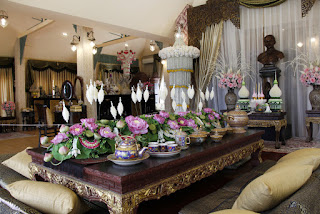Buri Ram province ups its attractions with a beautiful
botanical garden and luxury resort
THAILAND MIGHT still be in the grips of the monsoon but the
cool season has already arrived at Play La Ploen Floral Park in Buri Ram where
colourful winter blossoms are in full bloom.
Located in Khu Muang district, Play La Ploen is the first flower park in
the country’s northeast region and brings together an extraordinary mix of Thai
culture and exotic European designs under one roof. Spread over 400-rai, this
botanical garden is home to six temperature-controlled greenhouses populated by
plants from around the world.
The Seasonal Plant greenhouse shines the light on romance
with Dutch hydrangea varieties, amaryllises and Siam tulips.The “Love and
Loyalty” building hosts the “Under His Graciousness” exhibition that pays
tribute to His Majesty the late King Bhumibol Adulyadej. Alongside, the Tha
Sawang village showcases local wisdom through a collection of traditional silks
and ancient gold set off against a couple of white elephants fashioned from
flowers. Inspired by landscaped gardens
of which Europe is so proud, the Seasonal Plants greenhouse alternates its
displays every three months. Until November, it’s adorned with a pastel carpet
of Holland hydrangea varieties, amaryllises and Siam tulips on a Romantic
Flowers theme. In December, it will be home to yellow tulips, lilies and other
winter plants as the nation celebrates the late King’s birthday.
Dinosaurs peek out from the ferns and petrified wood in the
Prehistoric. The Prehistoric zone looks as though it was designed by Hollywood
director Steven Spielberg with its Jurassic Park theme. Here dinosaurs are busy
hunting for food and more than 60 species of ferns are wrapped around petrified
wood. Several varieties of these non-flowering plants are on display here,
namely the rabbit foot fern, ladder fern, Brazilian tree fern and bear paw,
Pteridium and Blechuum orientale, all of which have adjusted to the tropical
climate and grow well in hot and humid surrounds.
Over in the Colour of Nature
exhibition, a giant butterfly has been fashioned from orchids, chrysanthemums
and carnations. The show itself is divided into two themes – mainland and ocean
- boasting bromeliads and coloured carnivorous plants with other shrubs
fashioned as peacocks, parrots, lady bugs and mermaids. Mostly found in Mexico,
Brazil, Chile, Peru, Columbia and Costa Rica, bromeliads have some 25,000
species and in Thailand are categorised into two groups – edible (pineapple)
and ornamental.
On view here are the neoregelia, aechmean, guzmania, vriesea
and tillansia varieties. They share space with a range of carnivorous plants
from Asia, the Americas and Australia, among them nepenthes, sarracenia,
drosera, Venus fly trap and pinguicula. The Kinnaree garden boasts several
kinds of orchids. Next door is the mythical Kinnaree garden influenced by the
Thai literary work “Phra Suthon and Nang Manohra”. It’s home to rare orchid
species including the ground orchid, red orange star, vanilla sweet,
rhynchostylis retusa, cattleya, vanda and mokkara plus even rarer strains such
as aristolochia ringens vahl and aristolochia Indica L.The Great Pyramids hall
is home to replicas of pharaoh Tutankhamen and Cleopatra’s tombs and a wide
variety of rare cacti.The Great Pyramids hall has, as the name suggests, an
Egyptian theme with replicas of the tombs of Pharaoh Tutankhamen and Cleopatra
surrounded by a sea of cacti in full bloom. Species include agaves, candelabra
plant, silver torch and crested euphorbia.The Art of SEA pavilion mimics an Isaan village with a spread of anthurium from the Netherlands. The Art of SEA zone is designed to resemble an Isaan farming village and furnished with a collection of wooden agricultural tools and traditional costumes. They are surrounded by anthurium or dok na wua in Thai, a monocotyledon plant and native to the tropics that boasts heart-shaped leaves and petals that turn from yellow to white when it blooms. The exhibition focuses on seven species imported from the Netherlands including otasu, Dakota, sense, fiorino, jori, okapi and sempre.
Ruen Tam Rab Sam Rab Thai takes inspiration from a Thai-style wooden house. A short walk from the greenhouse zone, Ruen Tam Rab Sam Rab Thai is a beautiful Thai-style wooden house furnished with rare antique ceramics, porcelains and wooden tables from the reign of King Rama V.Visitors can sign up for workshops on Thai desserts, natural fabric dyes and handicrafts. Visitors to the gardens are invited to join workshops on naturally dyed fabric, Thai desserts and handicrafts and can make a holiday of it by staying overnight at the Play La Ploen Boutique Resort. Right now Play La Ploen is gearing up for winter by preparing a cosmos field, strawberry plantations and a vineyard. IF YOU GO Play La Ploen Floral Park is located at 252, Khu Muang district, Buri Ram province. It’s open daily from 9am to 6pm. Tickets are Bt80 for children and Bt150 for adults. Find out more at (087) 797 6425, (044) 634 736-8 or visit www.PlayLaPloen.com.





















